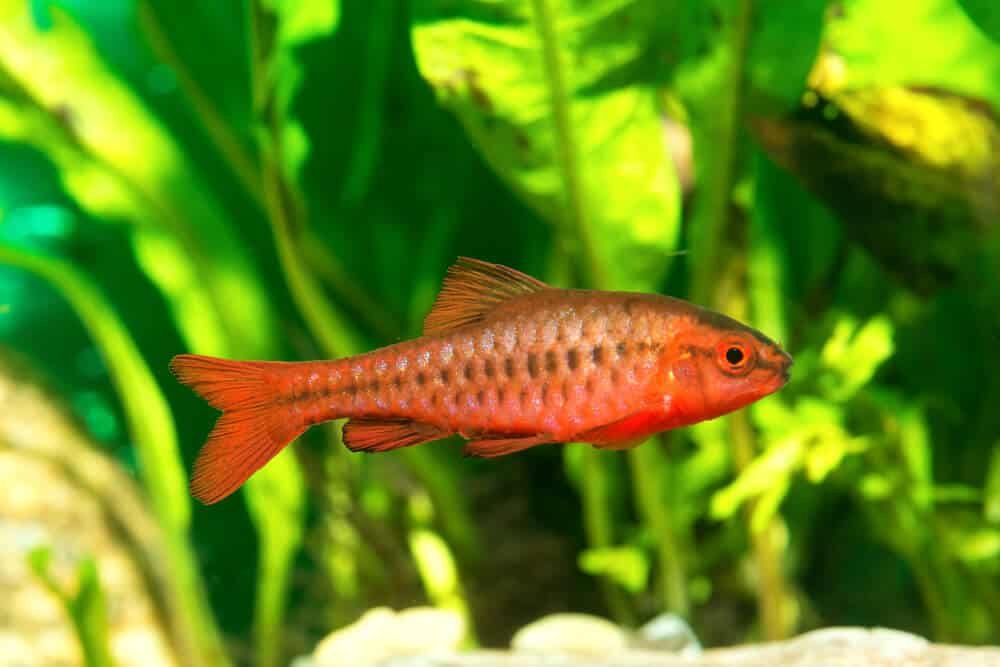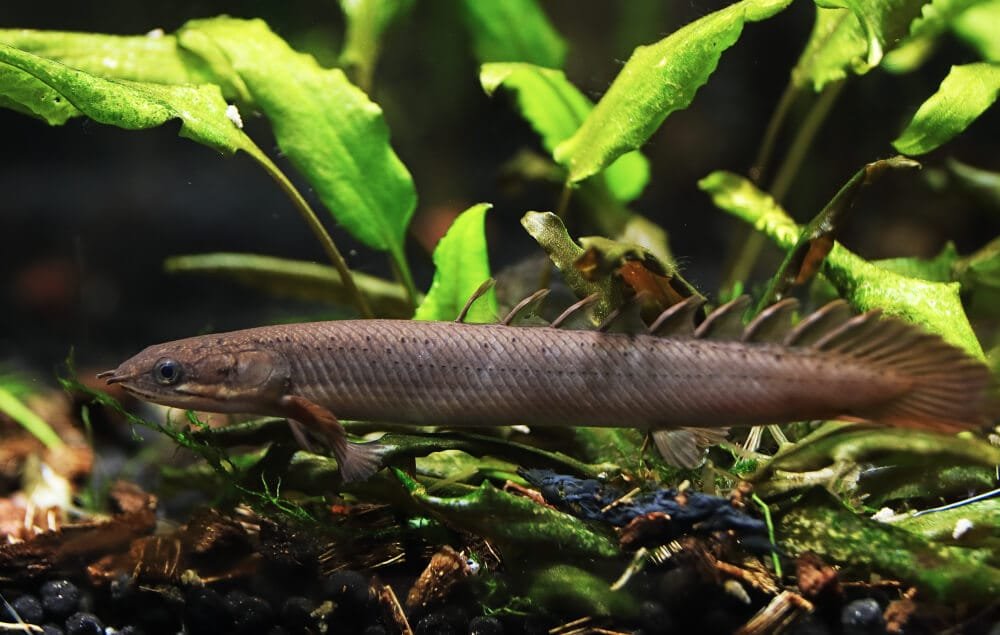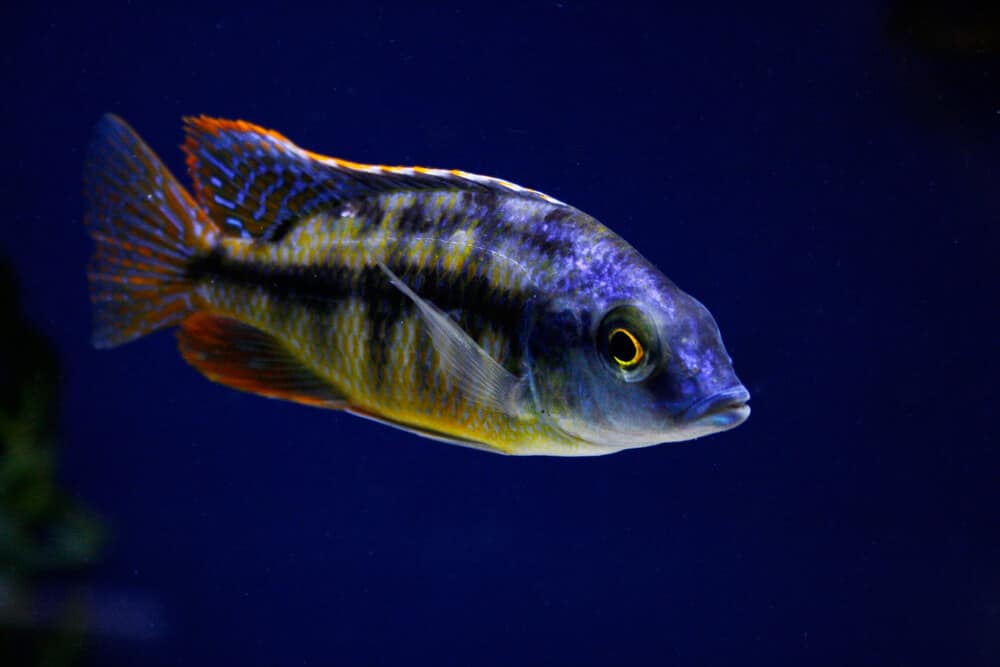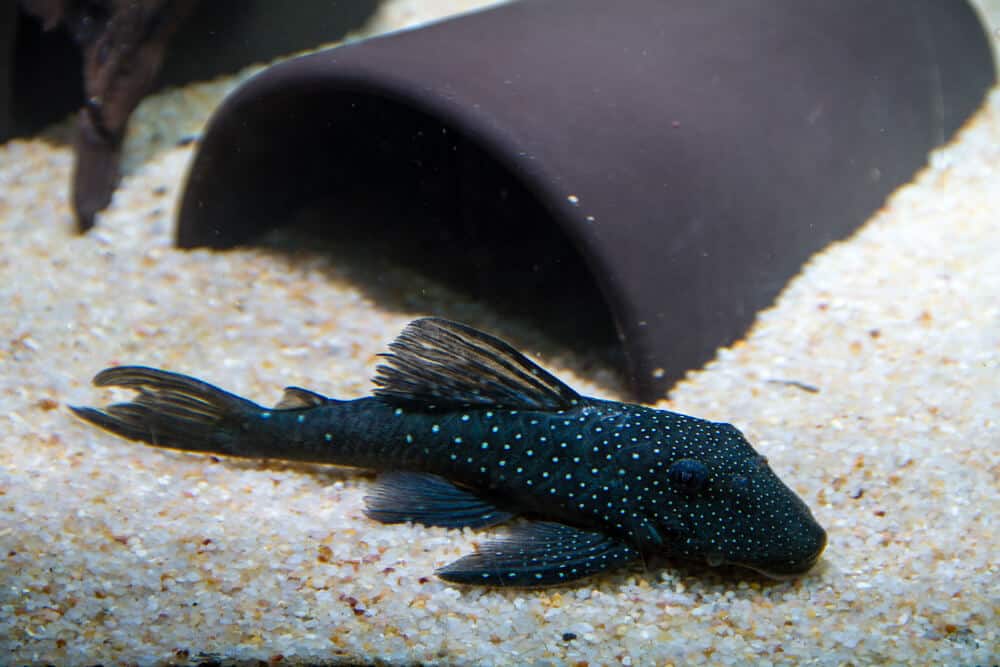Cherry barbs are famous among aquarists for its brightly colored appearance and schooling environment. This hardy fish species is recommended for both expert aquarists and beginners alike.
As a beginner, you need to have the right amount of knowledge regarding how to take care of them, especially when it comes to setting up a fish tank.
Cherry barbs are fun and beautiful to watch inside a fish tank. So if you are looking for a freshwater fish that is perfect aesthetically, then you’d never go wrong with picking this particular species.
To get a deep dive into this species, let’s cover first, cherry barb best tank mates and then look at this guide on how you can take care of them.
The 14 Best Cherry Barb Tank Mates
Since cherry barbs are peaceful in nature, the selection for cherry barb tank mates is quite long.
When mixing them with other species, a crucial factor to consider is that they should not be mixed with any more significant or aggressive species. The perfect tank mates for them are those peaceful species or bottom feeders.
Without further ado, here are the 15 best tank mates that cherry barbs can live peacefully with:
1. Harlequin Rasboras

Size: 2 inches
Min Tank Size: 10 gallons
Temperate: Peaceful and non-aggressive
Diet: Omnivore
Care Level: Easy
Rasboras are a species that come in an array of sizes, colors, and shapes. This species is one of the top choices as cherry barb tank mates as they are also peaceful dwellers. Also, they are mid-feeders, so you may want to consider feeding them with food that floats in the center.
The Harlequin Rasboras is a striking freshwater fish and one of the most common schooling fish worldwide.
This fish measures 2 inches in length and can fit in a 10-gallon tank. It is known to be very peaceful and does not show signs of aggression when with other fish species. This makes an excellent tank mate for the Cherry Barb.
What’s more, it is very easy to take care of and doesn’t get sick very often.
2. Diamond Tetra

Size: 2 – 2.4 inches
Min Tank Size: 15 gallons
Temperate: Peaceful
Diet: Omnivores
Care Level: Easy
This fish is a notable and eye-catching species that comes in various beautiful colors, shapes, and sizes. They are freshwater fish that thrives well in captivity and is a favorite to many hobbyists.
This fish measures about 2 to 2.4 inches, making it ideal for smaller tank sizes, up to 15 gallons.
When it comes to their behavior, they are known to cohabitate well with other species. They like to stay in groups and spend most of the time in the tank scavenging for food.
They also love to play but do not get aggressive with each other. Besides, they are easy to care for and please since they are natural omnivores.
3. Otocinclus Catfish

Size: Up to 2 inches
Min Tank Size: 10 gallons or larger
Temperate: Calm and docile
Diet: Herbivorous
Care Level: Easy
The Otocinclus Catfish, or Otos, are among the perfect tank mates to get along with your cherry barbs.
They prefer brown algae as their food, and they love swimming around and sticking themselves to surfaces. They also take a break occasionally to chase other catfish around.
These catfish live in freshwater and are very easy to care for. You simply need to provide clean water, plants, natural lights, and shading for the fish to do well. Otos tend to have a calm nature and are unlikely to harass other fish species.
Because of their pleasant personalities, they love to travel in schools with other peace-loving fish. There is no doubt that most people love to pair Cherry Barbs with Otos.
4. Kuhli Loaches

Size: Up to 5 inches long
Min Tank Size: 15 gallons
Temperate: Shy and reclusive
Diet: Omnivorous
Care Level: Hard
The Kuhli Loach is a freshwater fish that dwells well with others. Also known as Leopard Loach or Coolie Loach, the Kuhli Loach is one of the oldest fish that hails from Southeast Asia.
It has a slender body and small fins, making it easy to mistake it for eels. What’s more, they are multicolored and have dark stripes similar to a tiger.
Kuhli loaches love to dwell at the bottom of the aquarium because they have a snake-like appearance.
Generally, they prefer dimmer light and become active when you turn down your tank or aquarium lights. You should keep them in groups of 6, depending on your aquarium size. Moreover, they prefer sand as a substrate.
Contrary to popular belief, they are not very big and can measure up to 5 inches long at full maturity. You should note that taking care of Kuhli Loach can be very challenging, especially for beginners.
This fish has soft and faint scales that make it very sensitive and prone to diseases. Hence, the need to ensure the right water quality and temperature.
5. Mollies

Size: 4 – 4 ½ inches
Min Tank Size: 10 gallons
Temperate: Easy going & peaceful
Diet: Herbivorous
Care Level: Easy
Mollies are popular freshwater fish that are known for their peaceful nature and ability to adapt to most standard freshwater tanks. They can get along well with any peaceful fish, and the Cherry Barb is no exception.
Mollies come in different colors and types, including Sailfin mollies, Black mollies, Dalmatian mollies, Balloon mollies, Gold Doubloon mollies, and Lyretail mollies.
This fish species is easy-going and peaceful, making it a great addition to your Cherry Barb tank. Generally, they are shoaling fish, and they enjoy the company of other fish, and they enjoy being in the presence of others.
We recommend keeping them in a group of at least 4 or more if possible.
6. Rainbow Sharks

Size: 6 inches
Min Tank Size: At least 50 gallons
Temperate: Semi-aggressive
Diet: Omnivorous
Care Level: Easy
Rainbow sharks are fish that love to dwell at the bottom of your tank. They are not friendly to other fish because they are territorial, even with one another.
This is especially true when placed with fish that also love to dwell at the bottom of the tank.
Nevertheless, Cherry Barbs have been found to dwell peacefully with Rainbow Sharks despite their aggressive nature.
However, a good tip is to place your Cherry Barb in the tank first and then introduce Rainbow Shark later. You may also want to invest in a large enough aquarium to accommodate the 4-inch long rainbow shark at the bottom of your aquarium.
7. Celestial Pearl

Size: Up to 1 inch
Min Tank Size: 10 gallons
Temperate: Peaceful
Diet: Omnivore
Care Level: Medium
The Celestial Pearl is a type of rasbora, which is another perfect choice as a cherry barbs tank mate. They are also peaceful and consist of wonderful patterns and colors. Also referred to as galaxy rasbora, these fish are middle-dwellers and have a small size.
Despite being timid, they get along well with other fish, as long as they are of the same size and nature.
You need to imitate their natural environment and include plenty of plants. You need to watch over these fish, especially when courting, as men can get aggressive.
8. Kribensis

Size: 3 – 4 inches
Min Tank Size: 20 gallons
Temperate: Peaceful
Diet: Omnivore
Care Level: Easy
Kribs are the best choice for beginners as they can stay in above 20 gallons of aquariums.
Kribs and cherry barbs are compatible with each other, but you just have to make sure to keep their water’s pH between 6 and 7.
Originally from southern Nigeria, this dwarf cichlid is a colorful fish that prefers to dwell in shallow water. It is a peaceful fish, especially when kept with other cichlids that are not bottom dwellers. They are omnivorous and are very easy to care for.
9. Honey Gourami

Size: 3 inches
Min Tank Size: 10 gallons
Temperate: Peaceful
Diet: Omnivore
Care Level: Easy
Honey Gourami is a type of Gourami that is a great choice for novices and a perfect tank mate for the Cherry Barb. This is thanks to its peaceful nature and hardiness, rendering it very easy to care for.
This tropical fish has a similar appearance to that of Dwarf Gourami, but they are not the same species.
Coming from South Asia, this fish prefers warm water and requires a tank with a capacity of at least 10 gallons. They are omnivores and love tank setups with lots of vegetation.
10. German Rams

German Rams are a famous cichlid species that will go perfectly well as cherry barb tank mates. This species can be easily found and cared for with abundant information available on how to take care of them.
If you are thinking of getting a cichlid species, German rams are the perfect option for you, given that you have a 20 plus gallon tank to fit them.
11. Paradise Fish

Size: 2 – 3 inches
Min Tank Size: 20 gallons
Temperate: Aggressive with smaller fish
Diet: Omnivore
Care Level: Medium
The paradise fish is a popular member of the family of Gourami, which is known to be aesthetically beautiful because of its red and blue stripes.
This species can also get along with cherry barbs, but there’s a chance that they won’t be compatible with other species in your tank.
Unlike other Gouramis, this fish species thrive well alone or in pairs. This is because they tend to be aggressive with each other or with smaller fish. Hence, the best solution is to add a bigger and peaceful species that can look after themselves.
They love to swim and dwell in the upper levels of the tank. They are quite hardy and is immune to gourami disease.
12. White Cloud Minnows

Size: 1.5 inches
Min Tank Size: At least10 – 12 gallons
Temperate: Peaceful but get aggressive during mating season
Diet: Omnivore
Care Level: Easy
White cloud minnows are another type of hardy fish similar to cherry barbs.
Although their popularity has ceased for a while, they are still considered the best by the community, especially in an unheated aquarium.
This tropical fish stands out for its striking array of colors and its slim, streamlined body. They are very little in size, measuring 1.5 inches.
Maintaining this fish is very straightforward since it can tolerate a wide range of water quality and temperature fluctuations. Plus, it is peaceful and does not compete or harass their tank mates.
However, they may be territorial and aggressive during the mating season.
13. Corydoras

Size: 1 – 2.5 inches
Min Tank Size: 10 gallons
Temperate: Calm and peaceful
Diet: Omnivorous
Care Level: Easy
If you are thinking of a fish species to add to your cleaning crew, Corydoras is the perfect choice with a required tank of 10 gallons.
These little catfish are also considered bottom-dwellers since they spend most of their time swimming at the bottom of the aquarium searching for food.
Corydoras are freshwater fish that are quite hardy and easy to care for. They come in different types, colors, and sizes and are very social creatures that can cohabit with other species. They can also do well in different water conditions.
14. Swordtails

Size: 5.5 inches
Min Tank Size: 10 – 15 gallons
Temperate: Peaceful and friendly
Diet: Omnivore
Care Level: Easy
Another type of hardy fish is the swordtail which can grow for as long as six inches and has a tail extension that looks like a sword (most common in males).
For aquarists who fancy a colorful type of fish species that can survive in most types of aquariums, swordtails are the best choice. They are amazingly peaceful and friendly, and open to interacting with other fish.
However, to keep the peace, make sure that you maintain a higher ratio of females as men can be territorial. Their amazing feature is that they can reproduce if you only have females, as most of them are already pregnant before purchasing them.
They hail from North and Central America and are a favorite to most breeders. These freshwater fish are very adaptable and can thrive well in most environments, making them very easy to care for.
Besides, they can be kept in a 10-15 gallon tank, as long as they get space and some plants to hide. Also, they are omnivorous and can eat anything in the wild.
Cherry Barb Overview
The cherry barbs belong to the Cyprinidae family with the scientific name of Puntius Titteya. As mentioned, they are the most common freshwater choice among most aquarists due to their aesthetics.
Not only that, but they won’t decrease in number anytime soon as they are known to be the largest fish species worldwide. This species originated from Sri Lanka and is known to be a tropical fish.
There are also reports that these species are seen in some parts of Mexico, Panama, and Columbia. Cherry barbs are included on the Red List of IUCN as a vulnerable species because of their increasing demand in aquariums, which resulted in people catching more than they needed.
Another reason why their population is significantly decreasing is due to their natural habitat.
Because of its continuous decline in number in their natural habitat, one remedy for sustaining this species is through aquarium trade to allow them to thrive in a peaceful environment similar to their natural habitat.
Lifespan
Cherry barbs can live for 5 to 7 years on average, assuming they are well taken care of by considering their habitat set up, tank mates, and water condition.
Some aquarists would say that this species can last for eight long years by providing the best quality of care to their fish and taking the whole process seriously.
Appearance
The first thing that will catch your attention is the cherry barbs’ aesthetic beauty. As the name implies, this species appears to be cherry bright red from the head down to the toes.
Males are much more colorful than females, and they usually have vibrant red scales while females are paler.
Another feature that you will notice with this species is their dark line color that strikes down the center to their sides and appears dotted from the right side.
Furthermore, cherry barbs are hydrodynamic and can swim quickly due to their delicate and long body shape. They have standard fins such as dorsal fins that appear like a half-shell, and their pectoral and anal fins are medium in size.
Size
A fully grown cherry barb can reach a standard size of 2 inches. Also, it is common for them to only grow for an inch, depending on genetic factors and care level.

Care Guide
Most aquarists would say that cherry barbs are very simple to take care of, making them the perfect species for beginners who are looking for a low-maintenance fish.
Although they are easy to care for, there are a few measures that you still have to know before keeping them.
This guide is crucial to prevent them from acquiring diseases and health complications brought by unsuitable living conditions.
Water Parameters
The spacious room and its water parameters make the cherry barbs a beginner-friendly freshwater fish. The acceptable ranges are perfect for beginners who are still learning the process.
However, these levels should be strictly maintained as changes in parameters can lead to health issues. Below are the water parameters required:
- pH levels: 6 – 8
- dGH: 5 – 19 degrees
- Temperature: 73 to 81 degrees Fahrenheit
Regular water checking should always be in your to-do lists to continuously meet the parameters.
When doing the water testing, make sure to use an accurate and reliable water testing kit. Some kits are low quality, which could give you an inaccurate result, causing harm to your aquarium.
Tank Size
A cherry barbs’ tank size should be 25-30 gallons. This range is an acceptable tank size for you to fit the school of Cherry Barbs comfortably.
Setting Up A Tank For Cherry Barb
When setting up and organizing a tank for cherry barbs, you should make sure that it mimics their natural habitat.
Their natural environment is usually in calm and shallow waters with a lot of vegetation found on the surface, which means that one of your goals should be putting up a tank full of plants.
Another thing to consider is placing a substrate since cherry barbs are used to have deposits and dark substrates. Hence, darker sand is an ideal choice as it also adds to the overall quality and beauty of the aquarium.
Also, the bright cherry red color of cherry barbs stands out in a dimmer environment.
Moreover, you can add other decorations such as rocks, driftwoods, and caves as well. But these are only an option since your main goal is for the school of these species to swim quickly and freely to explore the aquarium.

Do Cherry Barbs Need Lighting?
Setting up a tank for your cherry barbs is an essential thing that you must do. This species tends to be agitated with bright lights and eventually stresses them out.
Thus, consider putting your aquarium in a more shaded place and must be away from the rays of the sun. Also, you may want to set up a dim light in a corner where you want to set up your tank.
Potential To Acquire Diseases
The cherry barbs’ best feature is their disease-resistant bodies. By nature, hardy fish species are not affected by a specific disease.
Although these species are hassle-free and easy to care for, they are not exempt from acquiring diseases, primarily if you do not provide them with the best quality of diet and a habitat that can lower the chance of getting sick.
A common freshwater illness that can contaminate your tank is Ich. This disease is manifested by white spots on your fish’s body and unusual behavior.
Hence, it is essential to inspect your cherry barbs regularly as other parasites and infections can affect them.
Diet And Food
When it comes to the cherry barbs’ diet, they are very flexible as they’re known to be omnivores and can eat any kind of food they can find.
Part of their diet are worms, small critters, algae, plankton, and tiny insects, but they also love to eat other creatures.
Most aquarists would feed them high-quality flake foods as their daily nutritional intake when in a tank.
In addition, foods high in protein are also a good choice for this species, such as blood worms and tiny shrimps.
Also, remember not to give them too much food when feeding them as they may experience health problems. Be cautious about how you feed them as well.
Behavior
As you know, cherry barbs are a very active species as they tend to move a lot, especially when they are together with harmless tank mates.
Another habit they do is swimming around with their kind, as this act makes them feel safer than moving around alone. Sometimes, you might see them swimming alone, but they will come back to their own group.
Moreover, a cherry barb is a peaceful fish species, and it definitely doesn’t want to attract any trouble.
However, it can be aggressive when mating as males come after females to demonstrate dominance.
Breeding
Unlike other species, cherry barbs are very easy to breed. You just need to have everything ready ahead of time, such as good habitat conditions and proper tanks for breeding and their eggs.
As a requirement, you will need a smaller tank for mating and another tank for their eggs. It is because this species may eat their eggs when they are placed in one tank.
Another thing that you may want to ensure is placing plants in your tanks for breeding, as they use plants to protect and hide their eggs from any other species.
Bear in mind, however, that you need to separate the fish and the eggs quickly.
Keeping Them Together
You need to consider things if you want your fish to be happy, and this is keeping them in a group. This species loves to socialize and needs to be in a group to keep them active.
If you own a few of them, then you will often see them hiding somewhere at times than swimming around. It is because cherry barbs prefer to be in a larger group to gain confidence and swim around, so their presence and beauty will be appreciated more by their owners.
The ideal ratio for their kind is 2 females to 1 male since this ratio will prevent males from becoming aggressive, especially during mating. Also, males usually harass females when spawning, so it is important to keep this ratio consistent.
If a male fish attacks a female fish, she will get health complications due to stress.

Frequently Asked Questions
Here are the top commonly asked questions about Cherry barbs and their compatible tank mates:
How Many Cherry Barbs Should Be Kept Together?
Cherry barbs must not be kept alone since they are a schooling type of fish. They stay with their group in the wild, so they must also be kept in groups during captivity. You must have at least six or more cherry barbs inside your aquarium. If kept alone, they tend to be shy and stressed.
Are Cherry Barbs Nippers?
Do cherry barbs nip fins of other fish? Well, the answer is yes. Just like any other barb fish, they are known to be nippy. However, if you house them properly, they don’t. So, if you see your cherry barbs nipping fins, you must reconsider your aquarium or tank setup.
Can You Keep Cherry Barbs In A 10-gallon Tank?
A 10-gallon tank for 8 cherry barbs is ideal when they are still babies. However, you must reconsider the size of your tank and give them room to grow. The best setup is to keep 10 cherry barbs in a 40 or 50-gallon tank.
Do Cherry Barbs Need An Air Pump?
Having an air pump and a filter will keep your tank clean and oxygenated, especially when you are planning to breed your cherry barbs.
Just like any other species, cherry barbs need a continuous supply of oxygen to survive. Moreover, they can thrive in moderate and low water movement inside the tank.
Are Cherry Barbs Easy To Breed?
Just like other fish like zebra danios and tiger barbs, cherry barbs are easy to breed. All you need to do is to allow them to reproduce. You will know if a cherry barb is male if you see that their bodies have a dark red color.
Final Words
Cherry barbs are one of the most popularly kept fish by either expert aquarists or beginners. Its popularity became known as they are very straightforward to care for, aesthetically beautiful, and very peaceful. That is why many owners recommend getting this type when deciding to have an aquarium.
If you can’t decide whether to keep them or not for any reason, read through this article and review all the facts that can help you in caring for them.
Once you become familiar with their needs, you will surely spend most of your time watching them swim around in your tanks, and you will definitely fall in love with them instantly.







